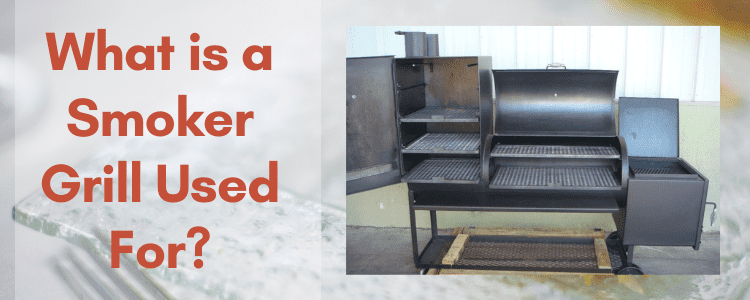A simple question when we heard about a smoker grill is “What is a smoker grill used for?” When you get your hands on a smoker grill, you’ll notice how much more equipped it is for barbecuing, especially when compared to a kettle grill. The smoke from the firebox on one side enters the cooking chamber, giving the meat its deep taste, melting suppleness, and crispy bark on the exterior.
However, there’s no denying that a smoker grill is more complicated than a kettle grill and that outstanding results can only be achieved if you know how to use it properly. Follow these simple instructions, give your smoker grill a few trial runs to calibrate it and nail temps, and you’ll be ready to smoke meat like a pro, whether you’ve chosen a basic or advanced smoker grill. In this article, we will delve into the world of smoker grills, understanding their purpose, different types of smoking, and the step-by-step process of how they work.
What is a Smoker Grill?
A smoker is a device that allows you to cook food at low temperatures in a controlled, smokey environment. It’s a piece of barbeque cooking equipment. There are many different sorts and styles of smokers now, ranging from simple electric machines to massive smoker rigs capable of feeding an army.
The process of smoking involves slow-cooking food at low temperatures while exposing it to the aromatic smoke generated by burning wood chips or chunks. This creates a delectable fusion of flavors, enhancing the taste and texture of various dishes.
Electricity, natural gas, wood, coal, and pellets are among the most common fuels used by smokers. Old-style smokers use wood to make smoke and heat while cooking their food. To produce smoke, smokers need the addition of wood in the hot room.
What is a Smoker Grill Used For?
Smoker grills are prized for their ability to transform ordinary ingredients into culinary masterpieces. Their primary purpose is to infuse food with tantalizing aromas and flavors of smoke, creating a unique and unforgettable taste experience. Smoking grills offer a range of benefits and applications.
Flavor Enhancement:
The key reason people turn to smoker grills is to enhance the flavor of their dishes. The slow and gentle cooking process, combined with the aromatic smoke from different types of wood, imparts a distinct taste to the food, elevating it to a new level of complexity and richness.
Tenderizing Tough Cuts:
Smoking is particularly well-suited for tougher cuts of meat, such as beef brisket or pork ribs. The low and slow cooking method breaks down collagen and connective tissues, rendering the meat tender, moist, and easily separable from the bone. The result is succulent and melt-in-your-mouth goodness that leaves diners craving more.
Preservation:
Historically, smoking was a method used to preserve food before the advent of modern refrigeration. The combination of low heat and smoke acted as a natural preservative, extending the shelf life of meat and fish.
Social and Recreational Activity:
Smoking food is more than just cooking; it’s a social and recreational activity that brings people together. Whether it’s a backyard barbecue with friends or a family gathering, the alluring aroma of smoking food draws everyone to the table, creating cherished memories and shared moments of enjoyment.
Types of Smoking in a Smoker
There are two main types of smoking techniques, each contributing to the unique flavors and cooking methods employed in this culinary art:
Hot Smoking:
Hot smoking is the more traditional and widely used smoking technique. It involves cooking food at higher temperatures ranging from 225°F to 275°F (107°C to 135°C). During hot smoking, the food is exposed to both smoke and heat simultaneously, resulting in fully cooked and ready-to-eat dishes.
The combination of smoky flavors and gentle heat not only enhances the taste of the food but also provides it with pleasing color and texture. Hot smoking is ideal for preparing a wide range of dishes, from succulent ribs and juicy chicken to delectable vegetables and even cheeses.
Cold Smoking:
Cold smoking, on the other hand, operates at much lower temperatures, typically below 90°F (32°C). Unlike hot smoking, the purpose of cold smoking is not to cook food but to impart a rich smoky flavor without raising the internal temperature significantly. To achieve this, the food is placed in a separate chamber from the smoke source, ensuring that the smoke reaches the food without cooking it.
Cold smoking is perfect for delicate foods that benefit from prolonged exposure to smoke, such as salmon, bacon, and certain types of cheese. It is important to note that cold smoking alone is not sufficient to cook food properly, so it is often combined with other preservation methods or subsequent cooking.
How a Smoker Works, Step-by-Step Instructions
A smoker works by cooking food at low temperatures while exposing it to smoke generated by burning wood chips or chunks. The process of smoking imparts a distinct smoky flavor to the food, enhancing its taste and aroma. Here’s how a smoker works:

Preparing the Smoker:
Before starting, ensure that the smoker grill is clean and free from any leftover residues. Select the wood chips or chunks of your choice, as different types of wood impart distinct flavors to the food. Soak the wood in water for about 30 minutes to prevent it from burning too quickly and to create a steady, smoldering smoke.
Lighting the Fire:
In the case of a water smoker, fill the charcoal chamber with briquettes or use an electric heating element. If you’re using a dry smoker, place the charcoal or wood in the firebox. Light the fuel and let it burn until it reaches the desired temperature. Remember, smoking is a slow-cooking process, and maintaining a consistently low temperature is essential.
Adding the Wood:
Once the fire is established, add a handful of soaked wood chips or chunks directly onto the hot coals or into a designated compartment in the smoker. This will create the smoke required for the smoking process.
Placing the Food:
After the smoker has reached the ideal temperature and a steady stream of smoke is being produced, place the food on the cooking grates. Arrange the items carefully, ensuring there is enough space for the smoke to circulate around each piece evenly.
Monitoring the Process:
Close the smoker’s lid to trap the smoke and heat inside. Use vents or dampers to regulate the airflow and control the cooking temperature. Depending on the type of meat and desired tenderness, smoking times can vary from a few hours to even overnight.
Note: It’s essential to remember that every time you lift the lid of your smoker, the internal temperature drops, disrupting the cooking process. Reestablishing the desired temperature can be time-consuming and may require additional fuel. This is where a temperature probe proves to be incredibly useful. By using a temperature probe, you can conveniently monitor the internal temperature of your food without the need to repeatedly open and close the lid.
Enjoying the Culinary Delight:
Once the food has absorbed the smoky goodness and cooked to perfection, take it off the smoker and savor the mouthwatering flavors that only smoking can provide.
What are the Different Types of Smokers?
Smokers can be classified based on whether they use wood pellets or other materials to generate heat; there are different types of smokers:
• Sticky Smokers
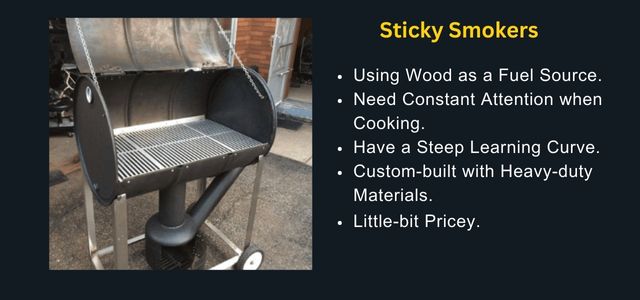
As the name implies, these smokers use just wood as a fuel source. They need near-constant attention when cooking and have a steep learning curve. These smokers are frequently custom-built with heavy-duty materials and are pretty pricey.
Offset smokers are sold at hardware and department stores. With each cook, you’ll gain experience and determine whether or not you need to upgrade to a more expensive model.
• Charcoal Smokers
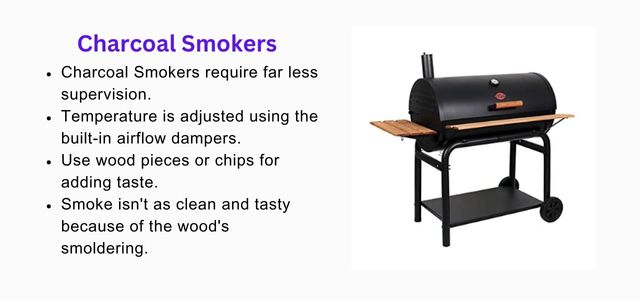
Bullet smokers (like the stainless steel Weber Smokey Mountain), ceramic kamado ovens (like the Big Green Egg), and drum smokers all fall under this category (like the Pit Barrel Cooker). While not wholly hands-off, charcoal smokers require far less supervision than a stick burner.
Once the coals are fired, you can adjust the temperature using the built-in airflow dampers. While charcoal produces the most smoke, you can add wood pieces or chips to add taste to smoking chicken or beef. However, because the wood smolders rather than combusts, the smoke isn’t as clean and tasty as that produced by a stick burner.
• Pellet Grills
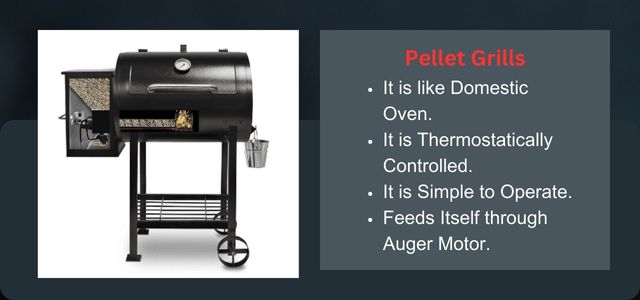
A pellet smoker or pellet grill, like a domestic oven, is thermostatically controlled. Plug it in, set the temperature, and the smoker will take care of the rest, feeding compressed sawdust pellets into a fire pot as needed for smoke and heat. You can get more smoke from the pellet grill by using wood or coal in the grill.
Pellet smokers are simple to operate, but their advanced technology makes them breakable in a manner that other smokers are not. While pellet smokers have their supporters, Aaron believes that alive, active fire may differentiate between excellent barbecue and good BBQ (or even bad).
• Gas-powered Smokers
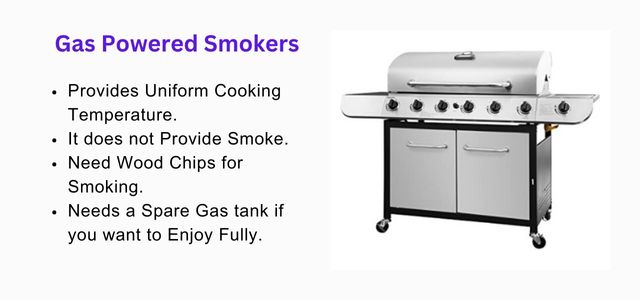
Because gas produces uniform cooking temperatures but no smoke, adding wood in the form of chips or pieces is required for barbeque. It would help if you had additional propane tanks available for lengthier meals since a single tank may not be enough.
• Electric Smokers
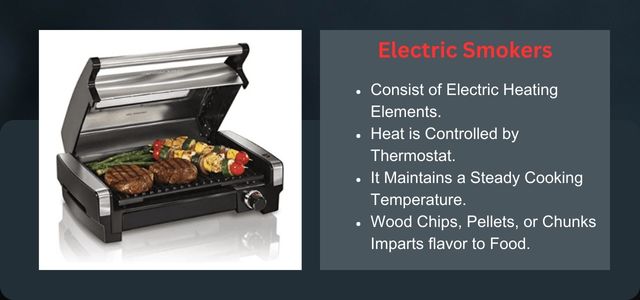
Electric smokers consist of an electric heating element that generates heat, typically controlled by a thermostat to maintain a steady cooking temperature. Some models may also have a digital control panel for precise temperature adjustments. These smokers use wood chips, pellets, or chunks to produce smoke, which imparts flavor to the food being cooked.
• Kettle Grills
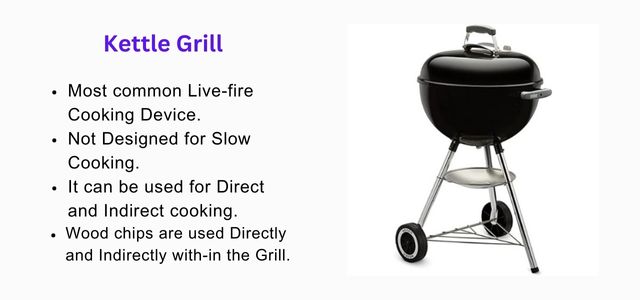
The basic kettle grill is the most common live-fire cooking device seen (and owned) by home cooks. Although kettle grills aren’t designed for slow-smoking meat, they can be used if approached carefully.
By confining the charcoal to one side of the grill, you can set up the grill for indirect heat. The wood chunks or chips you add to the charcoal will produce smoke. Make sure you have a thermometer close to where the chicken will be smoked.
• Bullet or Vertical Water Smokers
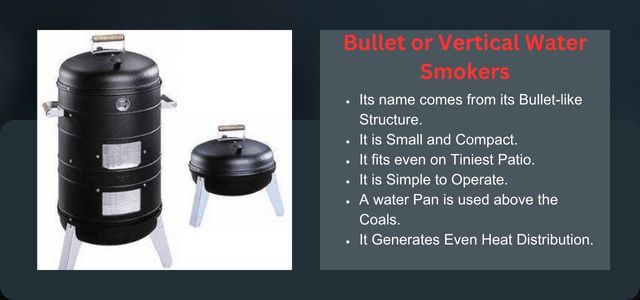
Many learners start with a bullet smoker, such as the Weber Smokey Mountain, which is one of the most popular charcoal smokers. The other is the dry smoker which works somehow differently. The vertical water smokers are small and compact, with a modest footprint that allows them to fit onto even the tiniest patios, have no powered or electrical parts, and are reasonably simple to operate.
Their name comes from their bullet-like form. These are fuelled by charcoal and wood bits in the bottom, with a water pan sitting above the coals to generate an even distribution of heat, catch dripping fat, and aid in creating a wet cooking environment.
How to Use Bullet or Vertical Water Smokers?
The meat would be placed on racks over the water pans, with a lid on the upper. Top and bottom vents can be opened and closed to control airflow and temperature. While many different sizes of bullet smokers are available, they are all relatively tiny and should be used to feed family and friends. This small smoker could easily accommodate 10-pound pork accepts or 8–10 racks of baby back beams.
Smoker vs Grill
Ultimately, whether you choose a smoker or a grill for your outdoor stainless steel kitchen will be determined by the type of food you wish to cook and your preferred method of food preparation. Do you want grilling equipment that is simple to set up and can feed large groups in a short amount of time?
Do you prefer to take your time and appreciate the flavor of a well-grilled meal? Remember that you don’t have to choose between the two. Many BBQ enthusiasts have a grill and a smoker in their outdoor kitchen. A ceramic egg smoker is a unique and famous grill/smoker that we incorporate into many outdoor kitchens we create.
Conclusion
A smoker grill is a special cooking tool that adds amazing smoky flavors to food. It’s very useful for making delicious dishes. It can make the food taste better, make tough meats tender, and help preserve food. Using a smoker grill also allows you to be creative in the kitchen, trying new flavors and cooking styles. Whether you’re a professional chef or just love cooking at home, trying out a smoker grill is a fantastic adventure that will make your taste buds happy and your heart content.
Enjoy smoky food ):

